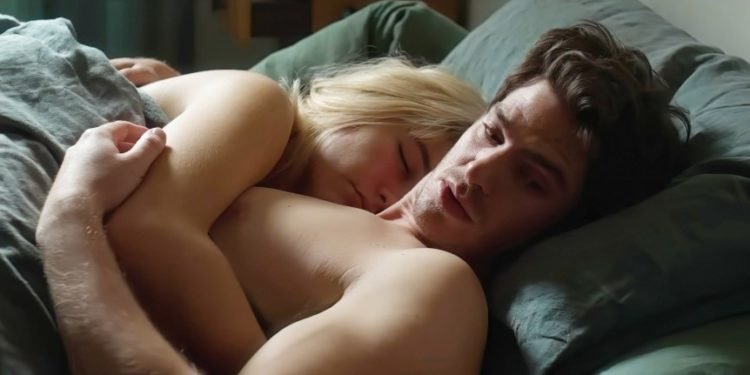We Live in Time (2024), directed by John Crowley and starring Andrew Garfield and Florence Pugh, is an emotional exploration of love, loss, and the fleeting nature of time. Released in October 2024, this romantic drama has already garnered attention for its poignant storytelling and stellar performances. The film takes viewers through a beautifully crafted journey of two individuals brought together by fate and bound by a love story that spans a lifetime. Garfield and Pugh shine in their roles, delivering heartfelt performances that elevate the narrative into something deeply moving.

Direction and Screenplay
John Crowley’s Cinematic Elegance
Known for his work in Brooklyn (2015), director John Crowley brings his signature touch of intimate storytelling to We Live in Time. Crowley allows the film to unfold like a series of delicate snapshots, portraying the various phases of Almut and Tobias’s (Pugh and Garfield) relationship. He skillfully blends moments of warmth with the cold sting of reality, capturing the complexity of love and life. Each scene is a carefully curated emotional beat that resonates deeply with the audience.
The screenplay, written by Nick Payne, adds layers of depth to the narrative. Payne’s writing effortlessly balances between lighthearted moments of humor and the sobering truths of time’s inevitable toll on relationships. His exploration of time, memory, and love taps into universal emotions, making the film relatable while also deeply philosophical.
Acting Performances
Andrew Garfield and Florence Pugh: A Dynamic Duo
Andrew Garfield and Florence Pugh are the heart and soul of We Live in Time. Garfield portrays Tobias with vulnerability and quiet intensity, while Pugh’s portrayal of Almut is equally compelling—rich in emotional depth and nuance. Their chemistry is palpable, as they navigate their characters’ unconventional love story with a sincerity that pulls the audience into their world. Whether it’s the joy of new love or the sorrow of inevitable loss, Garfield and Pugh deliver powerhouse performances that leave a lasting impact.
Cinematography and Visual Style
The cinematography by Sean Bobbitt (12 Years a Slave) deserves special mention. Each frame feels like a work of art, capturing the natural beauty of the film’s settings while also reflecting the emotional states of the characters. From the warm, golden hues of summer scenes to the stark, muted tones during moments of tension, the visual aesthetic mirrors the film’s exploration of the passage of time. Bobbitt uses lighting and framing to evoke the sense of fleeting moments, making time itself feel like a character in the film.
Sound Design and Score
We Live in Time also excels in its sound design. The score, composed by Oscar-winning musician Hildur Guðnadóttir (Joker), is both haunting and uplifting. Guðnadóttir’s compositions perfectly complement the film’s themes, blending melancholy strings with soft piano melodies. The sound design amplifies the emotional weight of each scene, subtly guiding the audience through the highs and lows of Almut and Tobias’s love story. The use of ambient sounds—such as the ticking of a clock or the rustling of leaves—further reinforces the passage of time, adding an auditory layer to the film’s central theme.
Themes and Analysis
A Meditation on Time and Memory
At its core, We Live in Time is a meditation on the impermanence of life and love. It explores how time, an ever-present force, shapes our relationships and memories. The film raises poignant questions about the fragility of human connections: How do we cherish fleeting moments, and what remains when time takes its toll? These themes make the movie resonate on a deeply personal level, encouraging viewers to reflect on their own lives and the relationships they hold dear.
Audience and Critical Reception
We Live in Time has received widespread acclaim for its thoughtful approach to storytelling and the powerful performances by its leads. Critics have praised the film for its emotional depth and the nuanced portrayal of love and loss. Audiences, particularly fans of romantic dramas, have found the film to be a moving experience, though some have noted its slower pace may not appeal to those seeking more conventional love stories.
Box Office Predictions
Given the strong word-of-mouth and critical praise, We Live in Time is expected to perform well at the box office, particularly among adult viewers seeking a mature, emotionally resonant film. Its limited release strategy, with plans for expansion, mirrors the successful rollouts of other romantic dramas, suggesting it could find a solid audience base both domestically and internationally.
Conclusion
We Live in Time is a beautifully crafted film that lingers in the heart long after the credits roll. John Crowley’s delicate direction, paired with outstanding performances by Andrew Garfield and Florence Pugh, elevates the film into a profound meditation on love, time, and memory. The cinematography and score further enhance its emotional weight, making it a must-watch for fans of introspective dramas. As the film continues to roll out across theaters, it is sure to leave an indelible mark on audiences worldwide.
Call to Action
If you’re a fan of deeply emotional stories that explore the complexities of love and life, don’t miss We Live in Time. Be sure to catch it in theaters while you can, and stay tuned for its potential digital release!

















